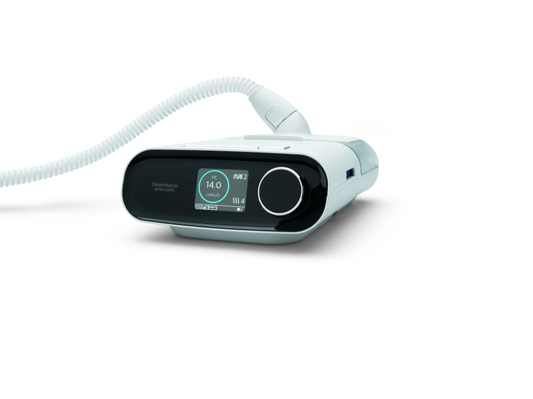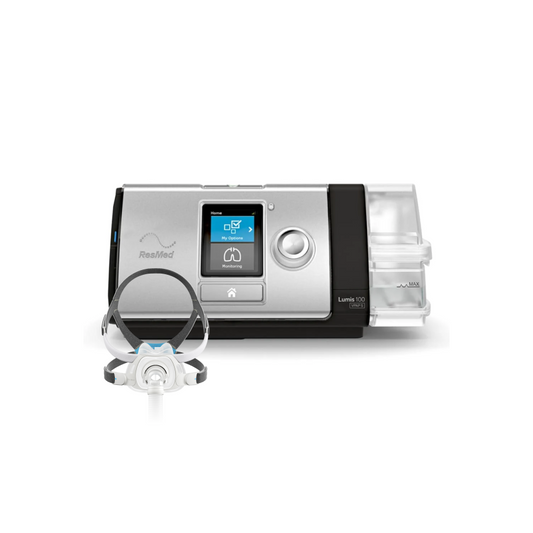Collection: BiPAP Machine
Treat and manage your sleep apnea condition with BiPAP therapy. Shop the range of premium BiPAP machines and BiLevel devices online at CPAP Discount Warehouse.
-
 10% OFFBoxing Day DealVendor:Philips Respironics
10% OFFBoxing Day DealVendor:Philips RespironicsPhilips DreamStation BiPAP AutoSV (ASV) Hum HT
Regular price From $3,599.00Sale price From $3,599.00 Reg: $3,999.00Unit price / perFree Shipping View productSale -
 44% OFFBoxing Day DealVendor:ResMed
44% OFFBoxing Day DealVendor:ResMedResMed Lumis 150 VPAP ST 4G with Built-in Wireless Connectivity, HumidAir and ClimateLineAir
No reviewsRegular price $4,088.00Sale price $4,088.00 Reg: $7,300.00Unit price / perSale -
 Vendor:ResMed
Vendor:ResMedResMed AirCurve 10 CS PaceWave 4G with Built-in Wireless Connectivity, HumidAir and ClimateLineAir
Regular price $3,599.00Sale price $3,599.00 Reg: $4,480.00Unit price / perSale -
 11% OFFBoxing Day DealVendor:Philips Respironics
11% OFFBoxing Day DealVendor:Philips RespironicsPhilips Respironics DreamStation Auto BiPAP HumHT
No reviewsRegular price From $2,395.00Sale price From $2,395.00 Reg: $2,699.00Unit price / perFree Shipping View productSale -
 10% OFFBoxing Day DealVendor:Philips Respironics
10% OFFBoxing Day DealVendor:Philips RespironicsPhilips DreamStation BiPAP AVAPS Hum HT
No reviewsRegular price From $3,599.00Sale price From $3,599.00 Reg: $3,999.00Unit price / perFree Shipping View productSale -
 16% OFFBoxing Day DealVendor:ResMed
16% OFFBoxing Day DealVendor:ResMedResMed Lumis 100 VPAP S 4G with Built-in Wireless Connectivity, HumidAir and ClimateLineAir
No reviewsRegular price $3,188.00Sale price $3,188.00 Reg: $3,828.00Unit price / perSale -
 36% OFFBoxing Day DealVendor:ResMed
36% OFFBoxing Day DealVendor:ResMedResMed Lumis 150 VPAP ST-A 4G with Built-in Wireless Connectivity, HumidAir and ClimateLineAir
No reviewsRegular price $4,799.00Sale price $4,799.00 Reg: $7,500.00Unit price / perSale
What is BiPAP machine?
A BIPAP mahchine is a form of non-invasive ventilation therapy (NIV) that makes breathing easier. It can be used both in hospital and at home if required. At CPAP Discount Warehouse, we offer a range of respiratory support devices, including Auto CPAP Machines, Travel CPAP Machines from BiPAP machine Resmed, Philips Respironics and Fisher & Paykel.
The BIPAP devices for home use are compact and about the size of a toaster. They have a tube connected to a mask that is worn over the nose and mouth. Similar to other ventilators, a BIPAP uses pressure to deliver air into the lungs. Depending on the settings, this helps to open up the lungs, improve oxygen levels in the blood and lower carbon dioxide levels.
These devices are called “bi-level ventilators” because they have two pressure levels:
On inhalation, the BIPAP delivers a higher air pressure, also known as inspiratory positive airway pressure (IPAP).
On exhalation, the pressure is reduced, which is known as expiratory positive airway pressure (EPAP).
Some BIPAP machine are equipped with a timer that can be programmed to ensure a certain number of breaths per minute.
What is a BiPAP device used for?
A BIPAP machine can be used at home to treat breathing difficulties associated with certain medical conditions such as: chronic obstructive pulmonary disease (COPD), obesity hypoventilation syndrome (OHS), sleep apnea, central sleep apnea and amyotrophic lateral sclerosis (ALS).
In hospitals, the BiPAP device is often used in respiratory emergencies. As it is a non-invasive therapy, it is often seen as the preferred alternative to intubation.
Doctors usually resort to a BIPAP machine when the situation is not yet severe enough for intubation. For example, a BiPAP can be used to treat respiratory failure due to COPD exacerbation, pulmonary edema or pneumonia.
It is also used to ensure regulated breathing when patients are taken off the ventilator after intubation treatment.
Who should use a BiPAP machine?
You could benefit from a Bilevel Machine if you suffer from one of the following conditions:
+ COPD: Chronic obstructive pulmonary disease
+ Pneumonia
+ Asthma attacks
+ Hypoventilation syndrome due to obesity
+ Sleep-related hypoventilation
+ Neurological diseases that affect breathing
+ This machines can also be used after surgery to help with breathing difficulties or prescribed for a diagnosis of heart failure.
*A BiPAP machine may not be suitable for everyone. We strongly recommend that you consult your doctor or sleep specialist to see if this device is suitable for you. As the device is only available on prescription, a doctor's prescription is required before you can use it.
It is important to have a thorough examination or sleep study before deciding on CPAP therapy. Doctors, specialists or your healthcare provider will only recommend a BiPAP machine if it is really necessary.
What’s the difference between BiPAP and CPAP?
What are the similarities between CPAP and BiPAP?
BiPAP and CPAP machines have a lot in common. Both deliver positive airway pressure (PAP) via a desktop device connected to a tube and mask. They can sometimes be used to treat similar conditions and have similar side effects.
Key Differences: BIPAP vs. CPAP
The main difference between BiPAP and CPAP is the way the pressure is distributed:
+ BiPAP machines provide two different pressure levels.
+ CPAP devices provide continuous air pressure.
+ CPAP is usually the first choice for treating obstructive sleep apnea. The continuous pressure keeps the airways open, which is why two pressure levels are not required. BiPAP, on the other hand, is often used as an alternative when CPAP is not effective or well tolerated. BiPAP delivers a higher pressure when inhaling and lowers it when exhaling. This makes BiPAP machines more comfortable and effective for some people with obstructive sleep apnea.
Why Choose BIPAP Therapy?
There are both advantages and disadvantages to choosing between BIPAP or CPAP therapy. Let's take a look at the advantages of BIPAP that often make it the preferred alternative to the more popular CPAP devices.
Advantages of BIPAP
BIPAP is particularly suitable for patients with breathing restrictions. People with breathing problems have difficulty taking in enough oxygen and exhaling carbon dioxide. A BIPAP machine from CPAP Discount Warehouse can solve this problem by improving gas exchange and supporting the body's natural function. It also removes harmful carbon dioxide from the body, which can be fatal in excessive amounts.
Easier exhalation with BIPAP
If your doctor determines that you need a higher air pressure when exhaling, a BIPAP device may be helpful. In contrast, when using a CPAP machine, it can be difficult to exhale properly because the air pressure remains constant. It is uncomfortable when exhaling is made difficult by the constant pressure.
Improving the breathing rhythm with BIPAP
BIPAP machine also optimize the breathing rhythm. Most BIPAP devices have a function that suggests an ideal breathing rate for inhaling and exhaling. The reason for this is that COPD patients often have difficulty exhaling and the constant pressure of a CPAP machine can be stressful for them. BiPAP for neurological diseases
How to Use Your BiPAP Machine?
Getting started with your BiPAP machine is easier than you might think. The first step is to connect all the components together. This includes attaching the humidifier and tubing to the device and connecting the mask to the tubing.
There are different types of CPAP masks, such as nasal masks or full face masks. It is crucial to choose the mask that suits you best to ensure a comfortable sleep.
Make sure your CPAP mask is properly assembled before connecting it to the machine's tubing. Once all components are correctly assembled, you can start using your BiPAP device.
FAQs
Is Resmed Aircurve 10 a BiPAP machine?
AirCurve 10 S: AirCurve 10 S can only be used in CPAP mode or spontaneous (S) BiPAP mode, unlike ResMed AirCurve 10 VAuto, which can also be used in Auto-BiPAP mode in addition to these modes.
Can I travel with a BiPAP machine?
No permission is required to carry or use a CPAP (Continuous Positive Airway Pressure) or PAP (Positive Airway Pressure) device on board our aircraft*. However, we recommend that you carry a medical certificate confirming that you need to use this device during your trip.
How long can a person stay on a BiPAP?
Although obstructive sleep apnea can be treated to significantly improve quality of life, a complete cure is not possible. When considering how long a person can live with a BiPAP device, it is important to bear in mind that, in cases of obstructive sleep apnea, it must be used every night indefinitely.








